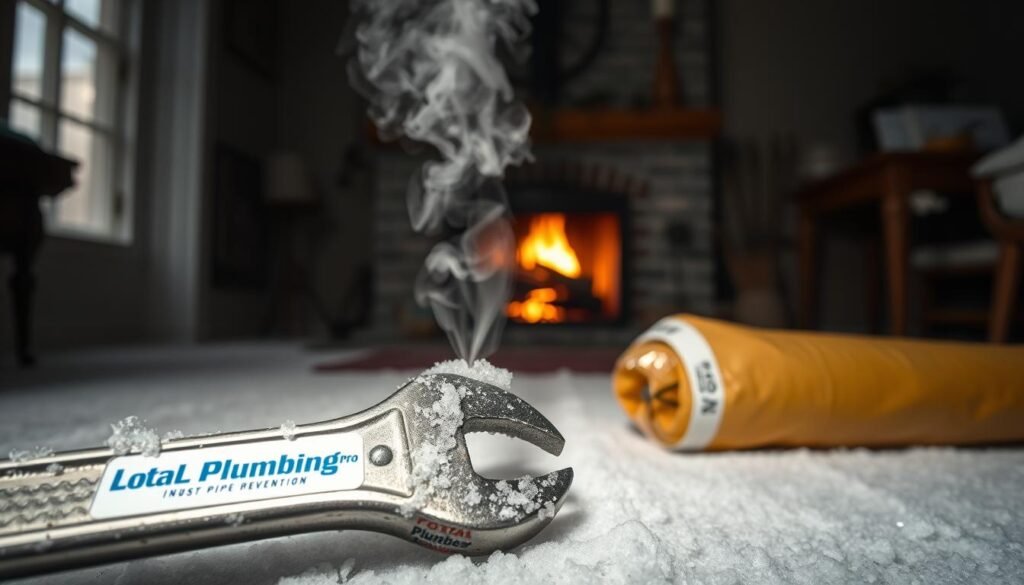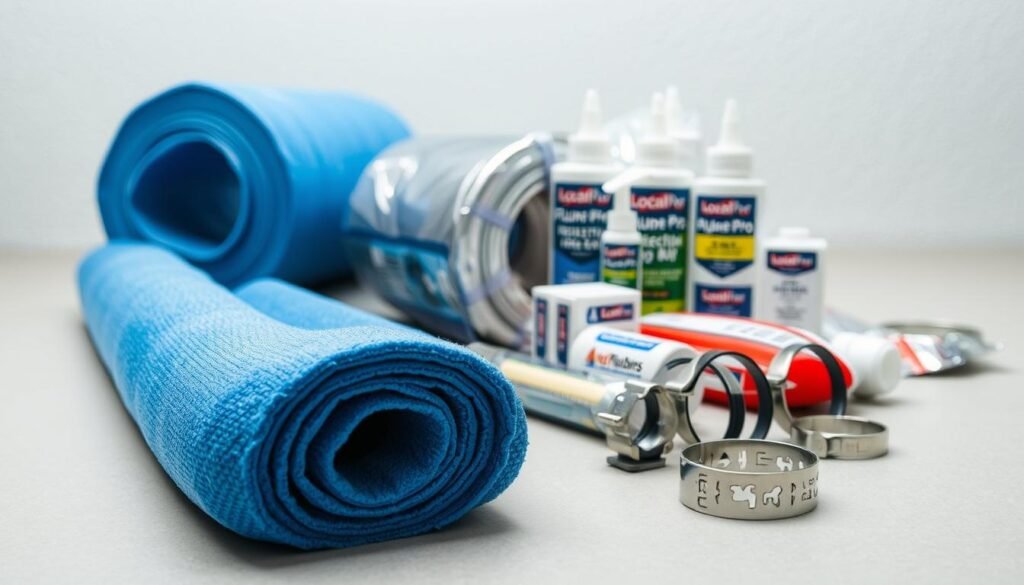Did you know a burst pipe can release up to 250 gallons of water daily? This can cause thousands in damage in just hours. Even in Southern California’s Inland Empire, where winters seem mild, cold snaps can drop temperatures below freezing overnight. This puts your plumbing at serious risk.
When water freezes inside pipes, it expands by nearly 10%. This creates tremendous pressure that can crack even the strongest materials. This pressure doesn’t always cause immediate failure. Sometimes pipes burst only after thawing begins, when water rushes to the weakened areas.
The most vulnerable areas in your property include unheated spaces like basements, attics, and garages. Pipes running through exterior walls or cabinets also face higher risks during cold weather. For homeowners and business owners in Riverside County, San Bernardino, and Corona, proper winterization techniques aren’t just precautionary – they’re essential.
At Local Plumbers 4 U, we’ve seen how a small investment in freeze protection can save property owners thousands in emergency repairs. Our team provides 24/7 emergency service throughout the Inland Empire at 909-378-9322. But we’d prefer to help you avoid disasters altogether.
Key Takeaways
- A burst pipe can release 250+ gallons of water daily, causing extensive damage
- Even Southern California properties experience pipe-freezing temperatures
- Unheated spaces and exterior wall pipes face the highest risk
- Water expands by approximately 10% when frozen, creating damaging pressure
- Preventative measures cost significantly less than emergency repairs
- Local Plumbers 4 U offers 24/7 emergency service at 909-378-9322
Understanding the Causes of Pipe Bursts
Pipe bursts are not random winter events. They are predictable physical reactions to freezing conditions. Homeowners can prepare for them. Knowing why pipes fail in cold weather helps protect your plumbing system.
Why Pipes Burst in Cold Weather
Water expands by about 9% when it freezes. This expansion creates a lot of pressure inside your pipes. Unlike most substances, water expands when it freezes.
As one plumbing expert explains:
“When water freezes, it doesn’t just get cold—it physically changes state and requires more space. The pressure from this expansion can exceed 2,000 pounds per square inch, enough to rupture almost any residential pipe.”
Pipes rarely burst where ice forms. Instead, they burst at weak points where pressure builds up. This is why water pipes burst in predictable patterns.

- Pipes along exterior walls with minimal insulation
- Water supply lines in unheated spaces (basements, attics, garages)
- Plumbing in crawl spaces beneath the house
- Outdoor fixtures like garden hose bibs and sprinkler systems
- Pipes in kitchen cabinets that border exterior walls
Effective freeze protection starts with identifying high-risk areas. Temperature monitoring systems alert you when conditions are dangerous. This usually happens when temperatures drop below 20°F (-6°C).
Common Signs of a Vulnerable Pipe
Knowing the warning signs of vulnerable pipes helps prevent bursts. Your plumbing system often shows subtle signs of trouble.
Look for moisture or frost on pipe exteriors. This indicates significant temperature changes. You might also see surface cracks or discoloration on the pipe material.
Inside your home, watch for these signs:
- Damp spots or mold on interior walls or ceilings
- Unexplained nail pops in drywall near plumbing
- Wall surfaces that feel unusually cool to the touch
- Reduced water pressure from specific faucets
- Strange sounds like creaking or banging from your plumbing system
Changes in water usage patterns can also indicate problems. Slow water flow or unusual pressure changes could mean partial freezing.
Regular temperature monitoring is key for seasonal properties. Smart sensors can send alerts when temperatures get close to freezing. This gives you time to act.
Previous repairs or patches on your plumbing system indicate weak points. These areas need extra attention to prevent future failures.
Essential Prevention Strategies
To protect your home’s plumbing from freezing, three key strategies are vital. Acting early can save you from costly repairs and water damage. Let’s look at these effective methods to keep your pipes flowing all winter.
Insulating Your Pipes Effectively
Insulating your pipes is your first defense against freezing. Pipes in crawl spaces, attics, and outside walls are most at risk when it gets cold.
Start by insulating all pipes in unheated areas. Foam sleeves are easy to use and affordable. Just measure, cut, and secure with tape or ties.

For really cold spots, use heat tracing cables. These cables wrap around pipes and turn on when it gets cold. They cost more but offer better protection.
When picking insulation, consider these factors:
| Insulation Type | R-Value | Cost Range | Installation Difficulty | Best Application |
|---|---|---|---|---|
| Foam Pipe Sleeves | R-2 to R-4 | $0.50-$3 per foot | Easy | Indoor pipes in mild climates |
| Fiberglass Wrap | R-3 to R-7 | $1-$4 per foot | Moderate | Outdoor pipes, colder regions |
| Heat Tape/Cable | N/A (Active heating) | $5-$10 per foot | Moderate | Extremely cold areas, problem spots |
| Rubber Pipe Insulation | R-3 to R-5 | $1.50-$4 per foot | Easy | High humidity areas, condensation control |
Don’t forget to insulate pipe bends and joints. For outdoor plumbing, use antifreeze. Also, insulate water shutoff valves, as they freeze easily.
Keeping the Heat On in Your Home
Keeping your home warm is key to avoiding pipe bursts. Never let your thermostat go below 55°F (13°C) when you’re away. This keeps pipes from freezing.
During cold weather, open cabinet doors in kitchens and bathrooms. This lets warm air reach your pipes.
If you’ll be away for a while, take extra steps:
- Ask a neighbor to check your home
- Use a smart thermostat for remote control
- Zone heating can save energy
- Drain the water system in vacation homes
Energy efficiency is important when heating your home. Use programmable thermostats to save energy. Set lower temperatures during the day and warmer at night.
Allowing Faucets to Drip
Letting faucets drip is a simple way to prevent freezing. Moving water is less likely to freeze than standing water. Even a small drip can help a lot.
Focus on faucets near exposed pipes or on outside walls. A drip rate of 5-10 drops per minute is good. It’s cheaper than fixing a burst pipe.
Run both hot and cold water lines for best results. If you have single-handle faucets, set them to lukewarm. This ensures water flows through both pipes. In very cold weather, you might need to drip more.
This method works best with proper insulation and heating. For complex systems or vulnerable areas, get professional help. Local plumbers can give you the best advice for your home.
By insulating, heating, and dripping strategically, you can greatly reduce pipe burst risks. Taking these steps now can save you from costly repairs later.
When to Call a Professional Plumber
Knowing when to call a professional plumber is key to avoiding damage to your property in cold seasons. While you can do some things yourself, some jobs need special skills and tools. Only experts have what it takes.
Trying to fix complex plumbing issues without the right knowledge can lead to bigger problems. It’s important to know when to ask for help. This is part of taking care of your home or business.
Signs You Need Expert Help
When you face pipe freezing or bursting, certain signs mean it’s time to call a pro. DIY fixes might not be enough.
- Pipes that stay frozen even when you try to heat them
- Visible damage like bulging, cracking, or moisture on pipes
- Many frozen pipes in your place
- Frozen pipes in hard-to-reach spots
- Freezing pipes keep happening even after you try to stop it
Using the wrong ways to thaw pipes can be dangerous. Never use open flames because it’s a fire risk and can harm the pipes. If you’re not sure what to do, it’s best to call a professional.
If you can’t find the frozen pipe, can’t reach it, or can’t thaw it safely, call a licensed plumber. Also, if a pipe bursts, you need a pro right away to avoid water damage.
How Local Plumbers 4 U Can Assist You
Local Plumbers 4 U is here for you in the Inland Empire, including Riverside County, San Bernardino, and Corona CA. We know the local climate and building styles that affect pipes. This helps us prevent pipe bursts better.
We’re ready 24/7 at 909-378-9322 for emergencies. Our team comes with the right tools to thaw pipes safely without causing more harm.
- Emergency pipe thawing with professional tools
- Safe and minimal pipe repair methods
- Checking your plumbing system to find weak spots
- Installing and maintaining water shutoff valves
- Custom maintenance plans for homes and businesses
We check your plumbing system to find weak points before they become big issues. Then, we create solutions that fit your property’s needs. This is for both homeowners and business owners in the Inland Empire.
Local Plumbers 4 U offers free consultations for those worried about pipe bursts. Our approach helps avoid costly emergency repairs by fixing problems early.
Visit our website at https://localplumbersincorona.com/ to learn more or schedule a free consultation. Remember, in cold seasons, getting professional help can prevent major water damage.
FAQs About Preventing Pipe Bursts
As winter approaches, you might wonder how to protect your plumbing. Here are answers to common questions about preventing pipe bursts.
What temperatures are most dangerous for pipes?
Water freezes at 32°F (0°C), but pipes usually freeze at 20°F (-6°C) or lower. The risk grows with longer exposure to these colds. Even in Southern California, winter nights can get this cold, making winterization key for your plumbing.
How can I check if my pipes are insulated properly?
Look for signs like moisture, mold, cracks, or cool walls. Check your pipe sleeves for damage. Run your hand over pipes to find cold spots. Use an infrared thermometer for better checks. Good insulation is vital to avoid expensive damage.
What should I do if a pipe bursts despite my precautions?
Act fast with these steps:
1. Shut off your main water valve right away
2. Call a licensed plumber at Local Plumbers 4 U for emergency help
3. Document the damage for insurance
4. Start removing water to lessen damage
5. Avoid the area if there’s electrical danger
For homes with heat tracing cables, check if they work well. Visit localplumbersincorona.com to get a free pipe burst risk assessment.
